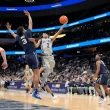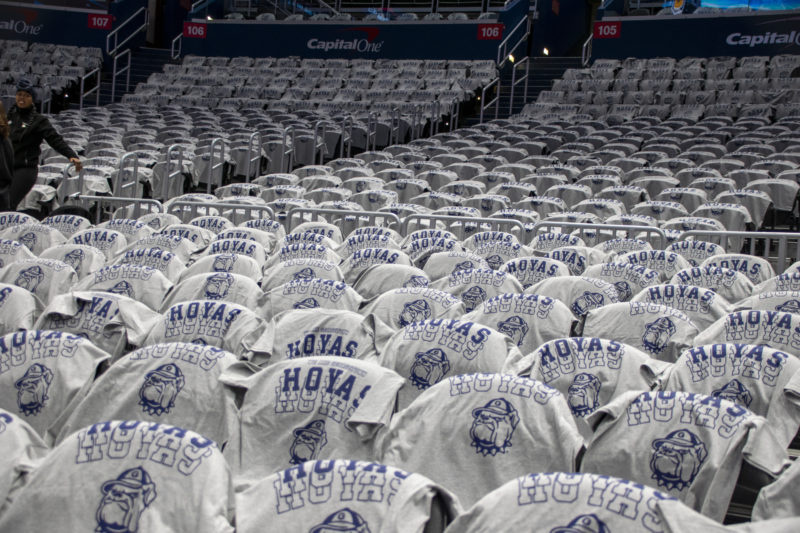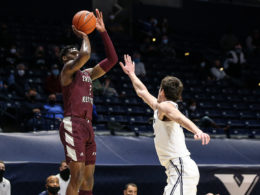For quite some time, a significant contingent of Hoya fans have dreamed of playing home games on campus. Somehow, I don’t think this is what they had in mind.
Last week, Georgetown released the team’s schedule for the first stretch of the 2020-2021 season. With this news came the unsurprising announcement that, at least through the month of December, home games will be played at McDonough Gymnasium without fans in attendance due to the health risks posed by the ongoing pandemic.
This move is consistent with similar measures taken by many of the Hoyas’ conference opponents. While several schools are yet to arrive at a final decision, Butler is currently the only Big East program expected to have fans at games. The Bulldogs announced this week that they will allow up to 2,275 fans- 25% of Hinkle Fieldhouse’s total capacity- in the stands. With the majority of Georgetown’s games to be played in empty arenas, what does that mean for the on-court product?
For many prominent programs, the impact of playing at home cannot be overstated. Inside Duke’s Cameron Indoor Stadium, a raucous crowd of ‘Cameron Crazies’ greets any opponent hoping to knock off the Blue Devils. I don’t mean to rag on Hoya fans, but the environment of Capital One Arena in no way compares to that of Cameron Indoor. Georgetown’s home court advantage is not even in the same ballpark as many of the Hoyas’ conference opponents. But don’t just take my word for it; let’s look at the numbers.
Against conference opponents since the start of Ewing’s tenure, the Hoyas are 10-17 (.370 winning percentage) at home compared to 9-18 (.333) on the road. Granted, this is a small sample size, but Georgetown’s home/road splits appear to be far less extreme than some (or perhaps all) of the Hoyas’ conference foes. Here’s each program’s home/road splits over the same time frame:
Villanova: 23-4 (.852) at home, 17-10 (.630) on the road
Creighton: 20-7 (.741) at home, 12-15 (.444) on the road
Seton Hall: 19-8 (.704) at home, 13-14 (.481) on the road
Xavier: 17-10 (.630) at home, 15-12 (.556) on the road
Marquette: 17-10 (.630) at home, 12-15 (.444) on the road
Providence: 17-10 (.630) at home, 12-15 (.444) on the road
Butler: 17-10 (.630) at home, 9-18 (.333) on the road
St. John’s: 11-16 (.407) at home, 6-21 (.222) on the road
DePaul: 8-19 (.300) at home, 6-21 (.222) on the road
Over the past three seasons, Big East schools have collectively won 58.9% of conference games when playing at home. Statistically, the Hoyas have benefited the least from playing at home within this time frame (when comparing the margin between home and road winning percentages). Georgetown’s home and road records are nearly identical, boasting just one additional win within the confines of Capital One Arena. Sure, some of this can be blamed on coincidence and small sample size. But when compared to the home successes of schools like Creighton and Butler, the statistical difference is jarring. For these schools, home court advantage is not an urban legend, but rather a real factor in deciding the outcome of games.
With restrictions placed on fan attendance (and most universities not allowing any fans), one would reasonably expect the impact of home court advantage to decrease. Sure, there admittedly are other factors at play, such as reduced travel times and increased comfortability playing at home, but the impact a home crowd can have on a game is far from insignificant.
Without the benefit of having fans to urge them on, players will have to create their own energy on the floor. This could pose a real challenge to teams who are used to having raucous crowds to rally behind. For Georgetown, playing in an empty McDonough Gymnasium may not feel all that different from a 9pm weekday tip at Capital One Arena (I kid, but the point still stands). Taking all this into consideration, playing with no fans might actually give Georgetown a comparative advantage over their conference opponents.
Does this mean I’m dreading the day fans will be allowed back in Big East arenas? Of course not. Just like the rest of the fanbase, I can’t wait for the day when we will once again be allowed to cheer on our Hoyas in person. In the long term, one can hope that a return to national relevance will breed a more active fanbase and the increased home court advantage that comes with it. But for now, I’ll take solace in the fact that playing in empty arenas may not hurt the Hoyas as much as it does other programs around the country.








